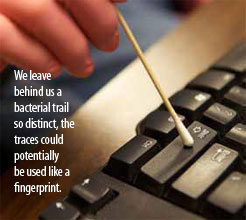
Touchy Subject
Recent research shows that we’re all walking microbial habitats ... women just a little more so
When running around the playground as kids, it was usually the boys who were thought to have more cooties. But a new study shows that when it comes to a handshake, women harbor more varied bacteria than men.
Noah Fierer, a CIRES Fellow and assistant professor of ecology and evolutionary biology at the University of Colorado at Boulder (CU-Boulder), looked at the microbial colonies making their homes on human hands. He found more than 4,700 species of bacteria distributed across 51 people. The average palm, he discovered, hosts about 150 different bacteria species. And when separated along gender lines, women, well, they house up to about 30 percent more kinds of microbes than guys.
Inevitable jokes aside, Fierer's study, co-authored by Micah Hamady of CU-Boulder's computer science department, Christian Lauber of CIRES and Rob Knight of CU-Boulder's chemistry and biochemistry department, illustrates the magnitude of bacterial biodiversity on the human body.
"I view humans as 'continents' of microscopic ecological zones with the kind of diversity comparable to deep oceans or
tropical jungles," Fierer said. "Today we have the ability to answer large-scale questions about these complex microbial communities and their implications for human health that we weren't even asking six months or a year ago."
By focusing on a technique known as "metagenomics"—sampling DNA directly from the microbe community—Fierer zoomed in on the lives of bacteria with a high-powered sequencing machine, distinguishing about 100 times more gene sequences than found in previous studies of skin bacteria. Standard skin culturing misses many of the microbial hitchhikers, his study shows.
No need to go nuts with the hand sanitizer, however. Most bacteria don't cause illness, and can even help protect against getting sick, said study co-author Knight.
As for the gender gap of microbial distribution, there could be several reasons for the difference. Women tend to apply more moisturizer and makeup, both of which could be sources of microbes especially because they tend be reused. Nature has its role too, including differences in sweat and oil glands, hormones, and pH. One thing's for sure, whether on the palm of woman or man, people are planets when it comes to bacteria. ![]()
![]()
For bacteria, getting respect can be hard. A bit of a boost came recently when Wisconsin declared Lactococcus lactis, the “bug” responsible for making all that yummy cheese, the state microbe. Now the little critters are getting more ‘cred’ from CIRES. Here are a few of the ways CIRES scientists are upping the WOW factor of the microbial world.
Human bodies, microbial planets
Microbial diversity doesn’t just apply to a person’s hands. A bacterium that lives on the forehead might turn its flagellum up at real estate on the elbow. CU-Boulder’s Rob Knight, Noah Fierer, and colleagues mapped bacterial communities across 27 sites on the human body and found that
different zones host unique types of microbes. Not only that, but one person’s bacterial makeup likely differs from another.
Bacterial crime fighters
Turns out when we touch things such as a computer keyboard or mouse, we leave behind an identifying trace of bacteria. These buggy clues could eventually play a role in solving who-done-its, as the microbes we leave behind are so distinct they act like a bacterial fingerprint. There’s still work to do in order to sort out the details, such as distinguishing between multiple users of an object. But lawbreakers beware: some day investigators might nail suspects after
swabbing for bacteria in crime scenes clean of prints or DNA.
The leafy loyalty of plant microbes
Trees, too, boast their own bacterial signatures, suggesting that trees and their “bugs” share a close symbiotic relationship. Noah Fierer and his team sampled bacteria from trees of several species and found each species with its own consistent microbial community. Unlike people, whose skin bacterial communities may differ from person to person, trees of the same species likely harbor similar types of bacteria, even if those trees live on different continents from one another.


